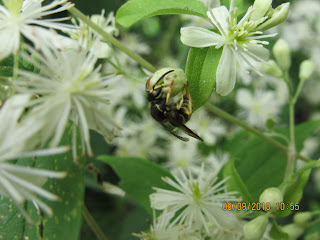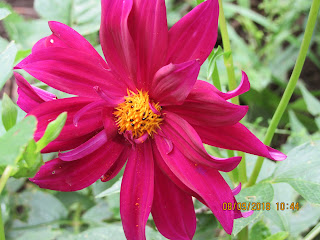Not true this year. I set out some very old traps to capture bunnies for release into other, more distant realms. None of the traps have worked so far. Kit wanted us to go for a walk in the north woods and it's had to refuse her commands. This morning she woke us all up because a deer had invaded the Hosta garden and had to be chased out. The indignant pack howled out; the huge deer escaped over the fence. I doubt the neighbors liked reveille.
When we got back to the porch after our woods wandering, one of the dogs was missing. Ha! We looked and found a bear in one of the traps. Actually, we found our Bear in one of the traps - silently waiting to be released. Bear has an insatiable curiosity and a hunger for brassicas. All the dogs love cabbage leaves, brussel sprouts, cauliflower, broccoli, which I give them regularly because they are health food for them and me. I used cabbage leaves to bait the traps for rabbits. Poor Bear. He calmly backed out once I figured out how to release him. (Clicking on photos enlarges them.)
Everywhere I've lived for several decades now I've brought along my wild clematis (Clematis virginiana). It is a vigorous grower and hard to keep in bounds but worth it for the blanket of flowers that completely covers my fence in the space of our short growing season, and all the while providing food for many insects and a summer privacy fence for my back yard that is also a neighbor friendly fence. In the late fall or early spring I cut the plants back to two or three inches. Growth is rampant. All the flowers I've ever seen anywhere are male; no seeds have ever been produced. Thankfully. Like Kudzu, they could easily take over if given half a chance.
At the base of one of the clematis plants are a struggling few Grandpa Ott's morning glories. I'll have to save some seeds and plant them where they don't have to compete (and lose) to the clematis next year.
Hummingbird young
Cup Plant
Cup Plant
Bergamot/Monarda
Bergamot/Monarda
Dahlia
Dahlia
(Can you find the ship?)
Voila




















No comments:
Post a Comment